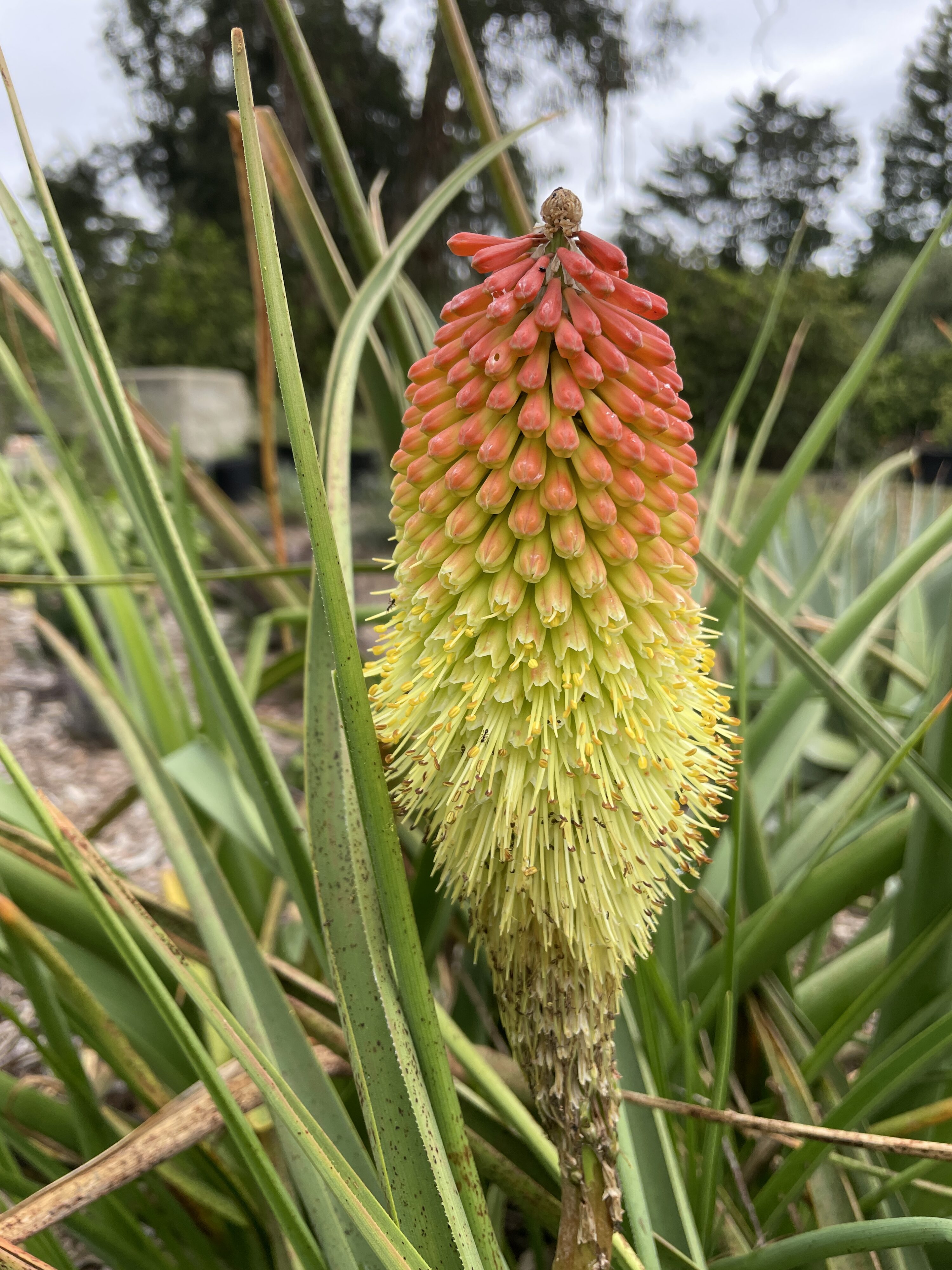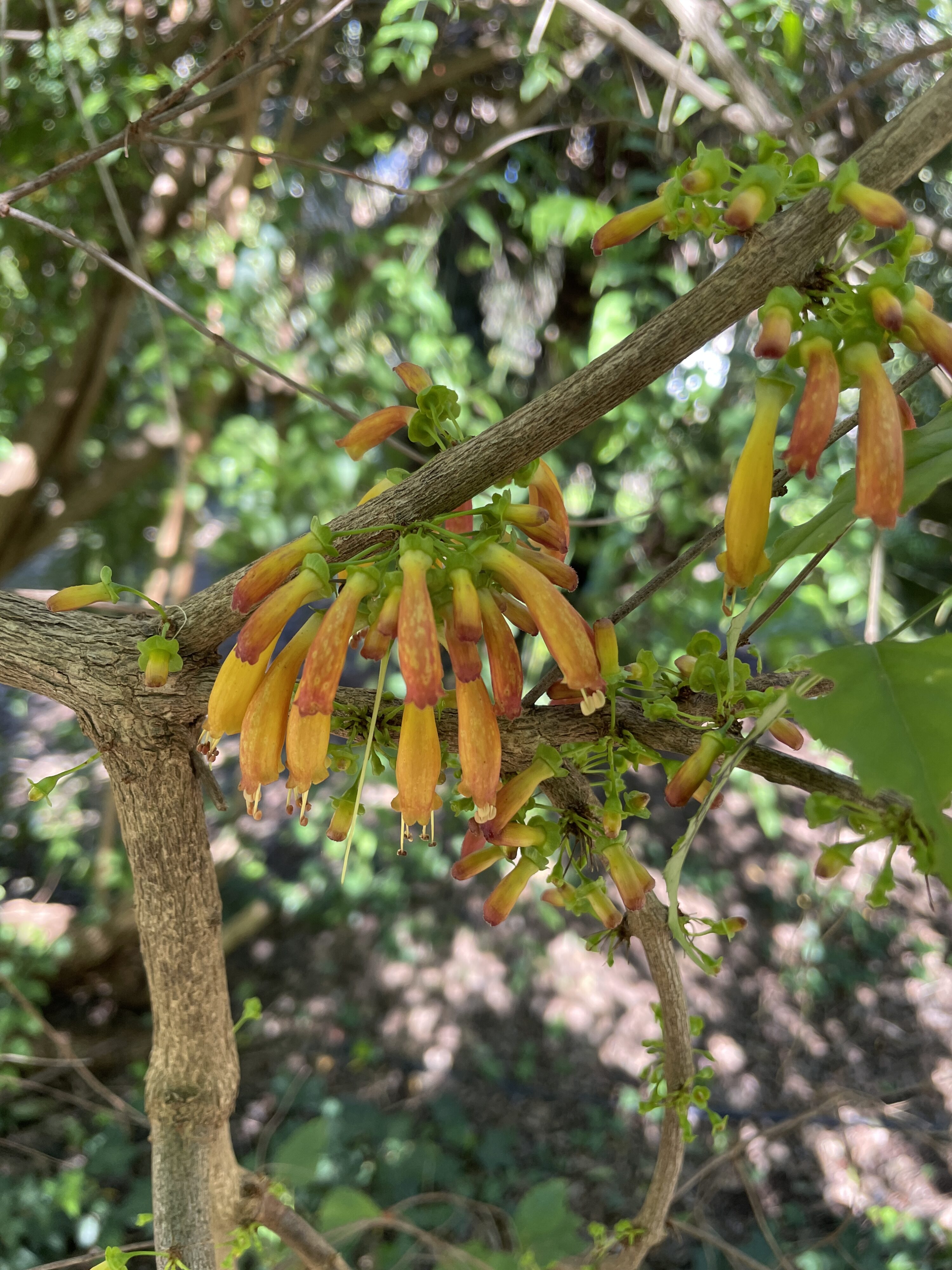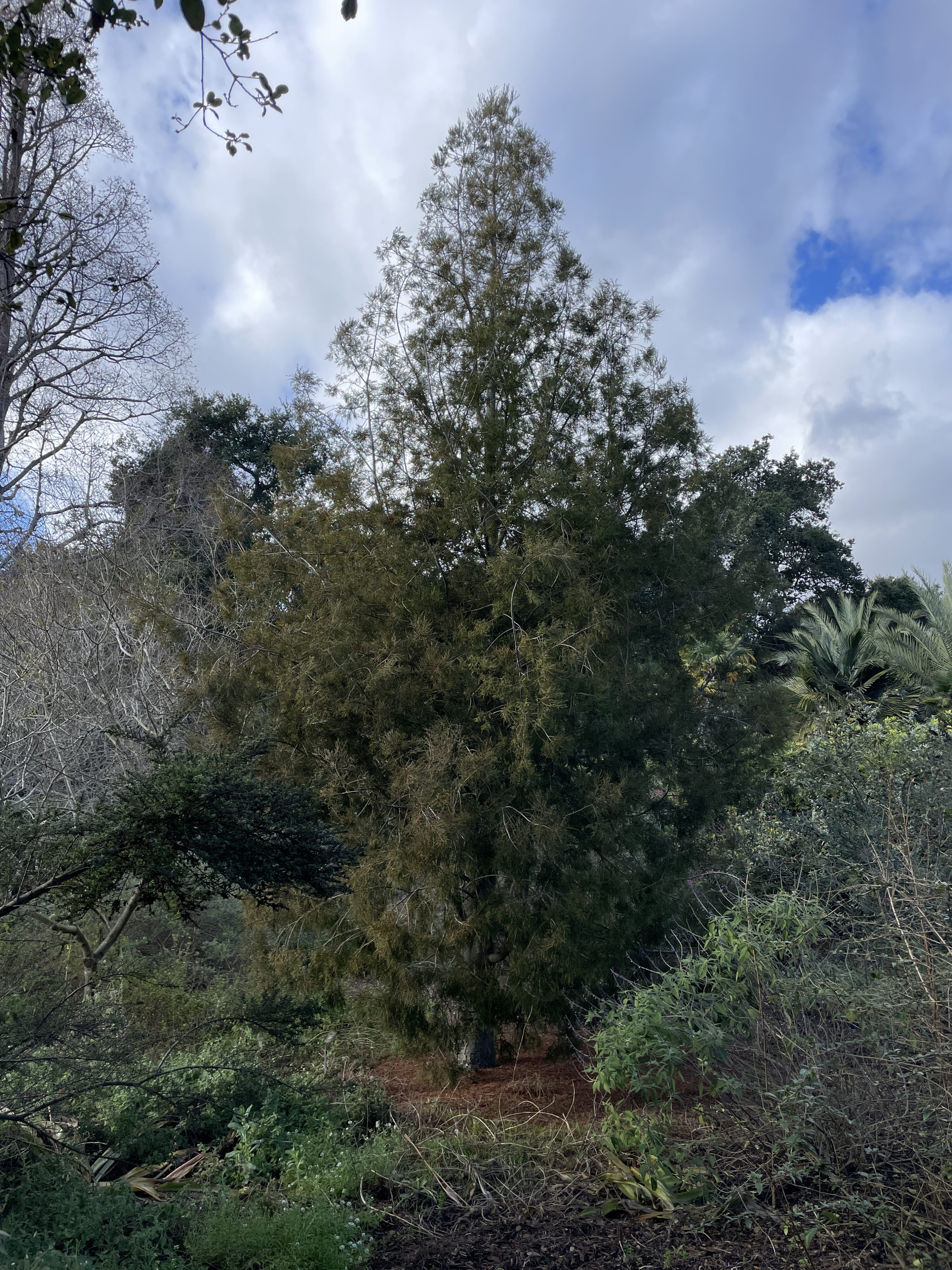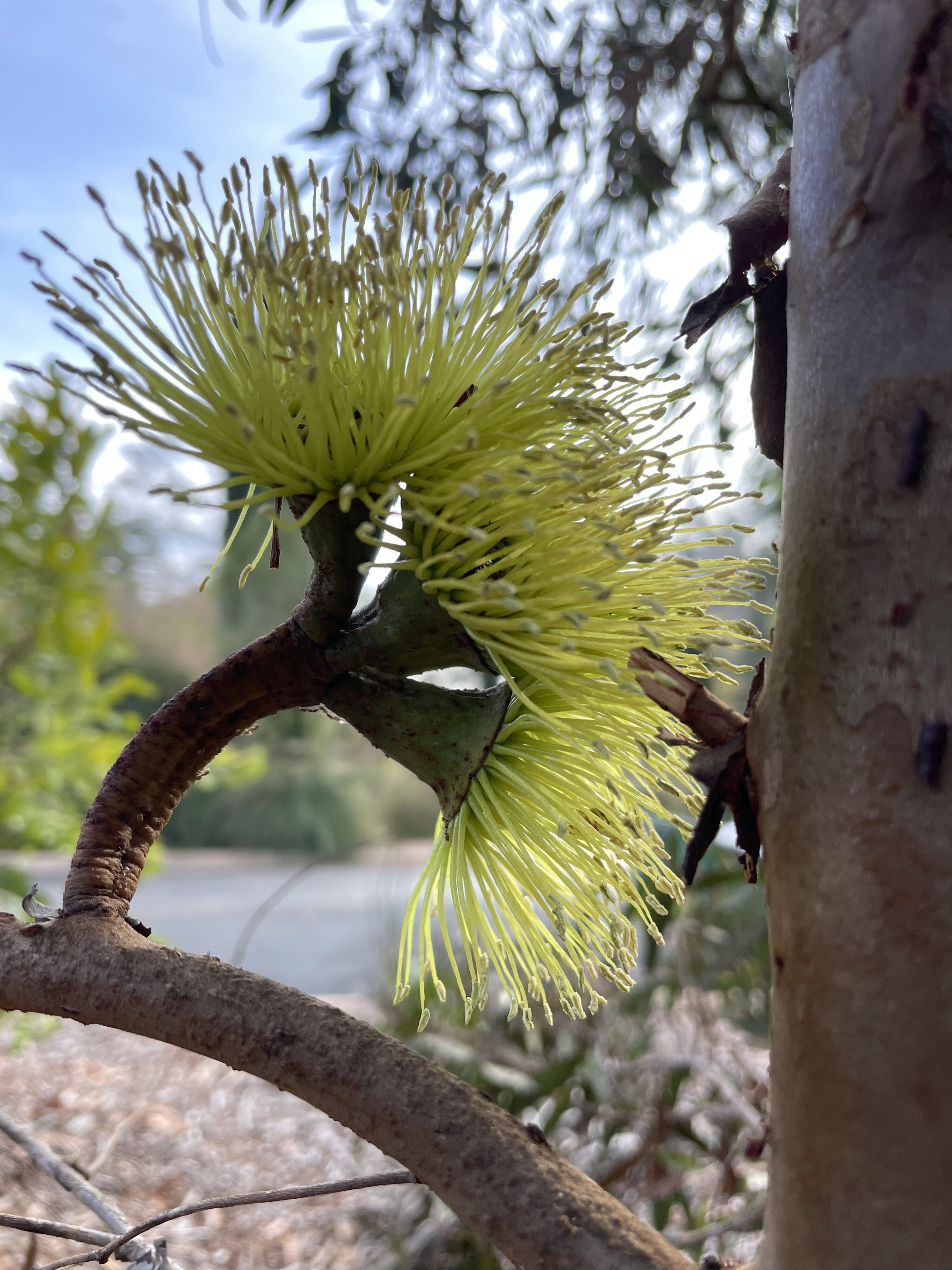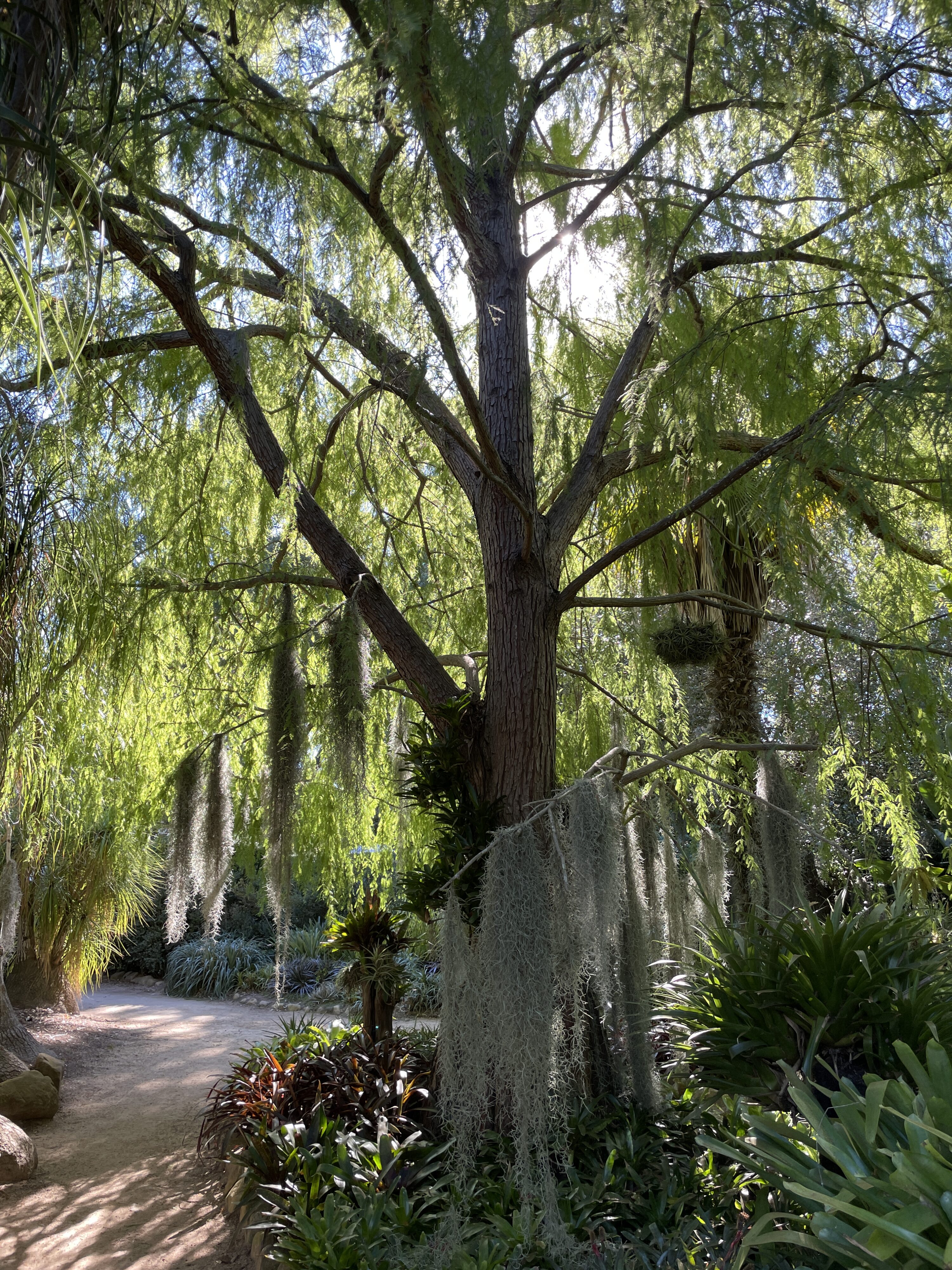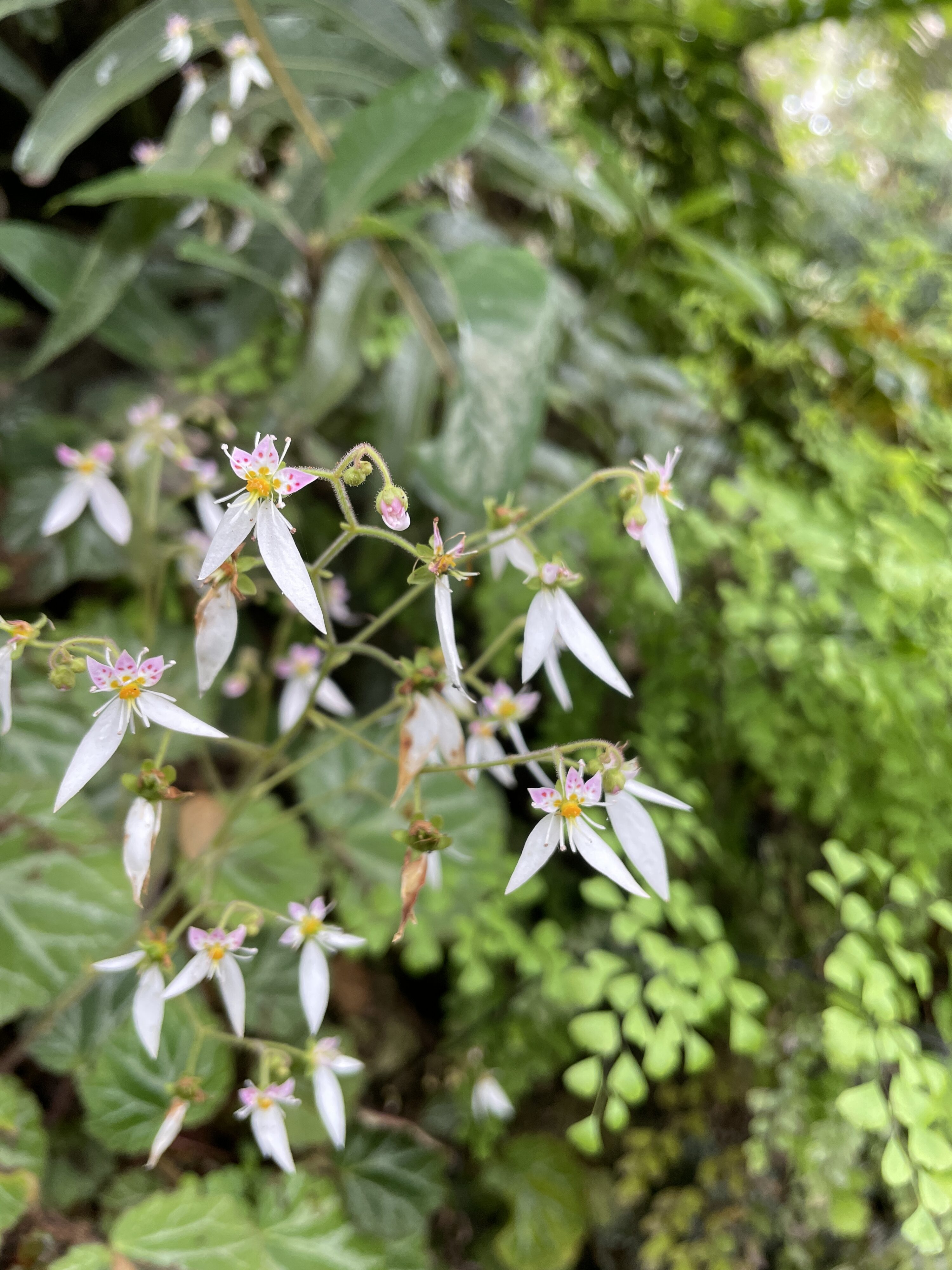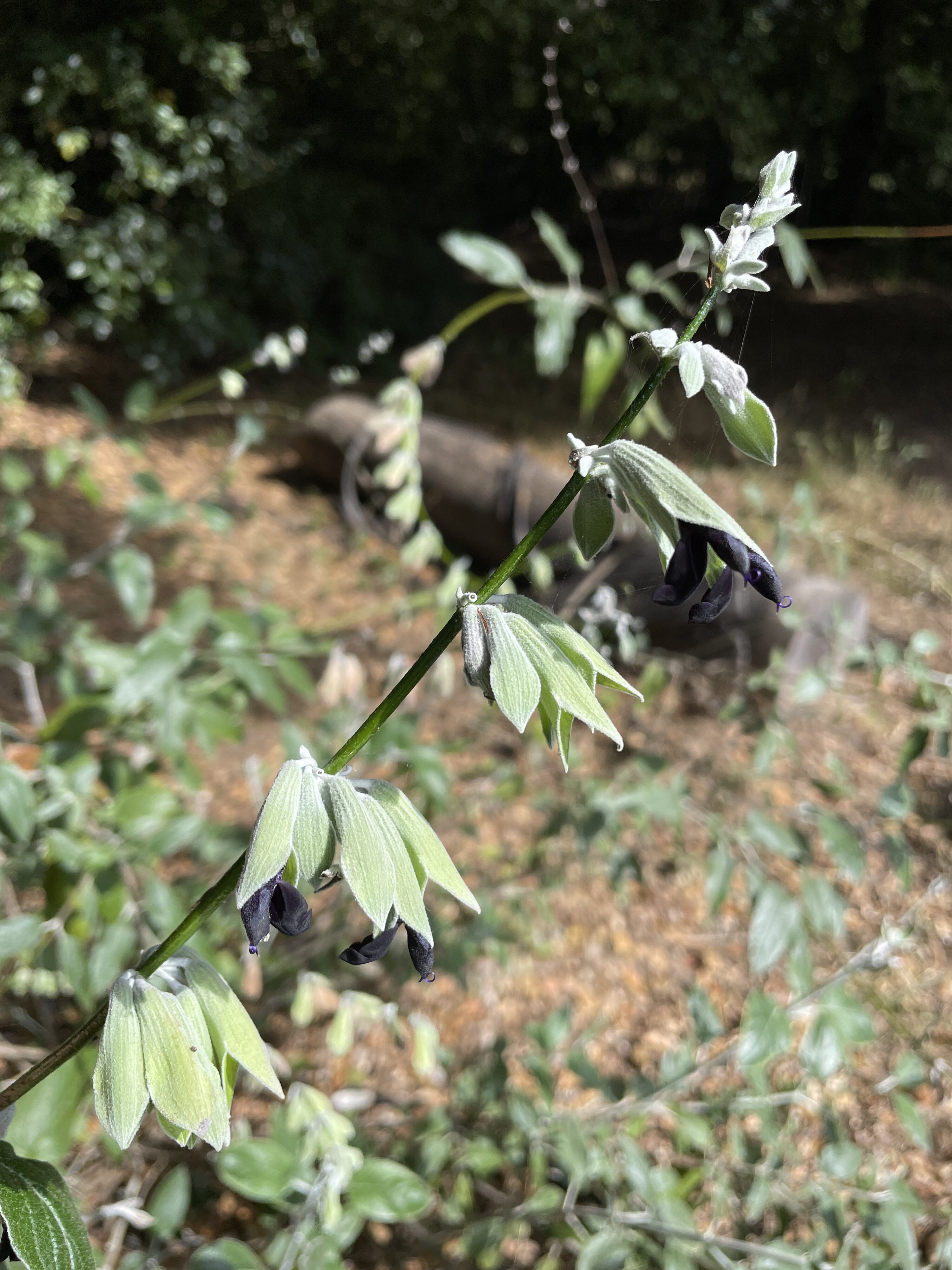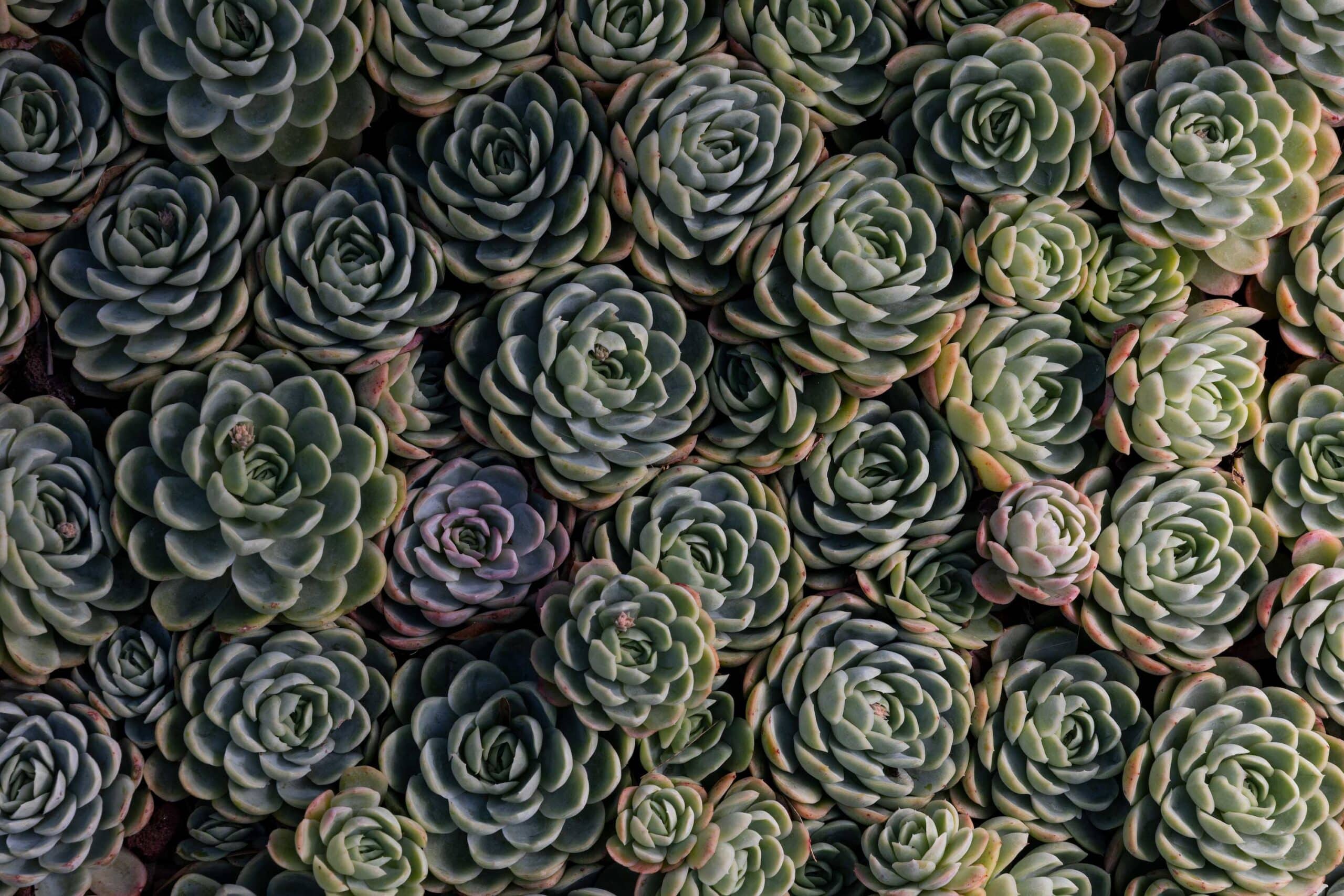
Plant Highlights
Plant Highlights
-
Kniphofia northiae
broad-leaved poker, giant red-hot poker, octopus torch
Highlight Month:
May
Nativity:
This species grows in steep areas and high elevation sub-escarpment savanna of the Eastern Cape of South Africa where it receives year-round rainfall.
Growth Habit:
This Kniphofia makes a statement in the garden with broad green leaves resembling a floppy aloe. Its evergreen leaves can reach 2’ long and are 6” wide at the base, forming a clump 4-6’ wide and 5’ tall. Plants in this genus are referred to as “red-hot pokers” because of their upright, brightly colored inflorescences. In the spring, Kniphofia northiae displays pink/red flower buds that open orange and fade to light yellow before senescing. The flowers are popular with nectar-feeding birds: sunbirds in South Africa and hummingbirds in the Americas.
Growing Requirements:
This species is drought tolerant but requires additional summer water. It is hardy to USDA Zone 6a (-10 °F), prefers full sun to light shade, and clumps of this plant can be divided every 5-7 years.
Features:
The genus Kniphofia contains 71 accepted species, all native to Africa, and is part of the Asphodelaceae, or asphodel family. The genus was named after Johann Hieronymus Kniphof (1704-1763), a German botanist and physician. Kniphof’s herbarium at Erfurt University in Germany was well-known for using a technique known as “nature printing” to imprint details of botanical specimens on paper using ink. The specific epithet, northiae, references Marianne North (1830-1890), an English botanical artist who would often travel solo to paint plants in naturalistic settings. The initial botanical description of this plant was based upon North’s painting of this species and a specimen in the Cactus House at Kew Gardens in London. Over 800 of her oil paintings are currently housed at the Marianne North Gallery at Kew.
Kniphofia northiae was awarded the Royal Horticultural Society Award of Garden Merit in 2006, a designation granted annually to plants of “outstanding excellence for garden decoration or use.”
Where at Lotusland:
Nursery
-
Halleria lucida
African honeysuckle, tree fuchsia, white olive, umbinza, notsung
Highlight Month:
March
Nativity:
The range of H. lucida extends from South Africa to Ethiopia and into Yemen. The genus Halleria belongs in the Stilbaceae family and contains five accepted species with two endemic to Madagascar.
Growth Habit:
Halleria lucida is a small evergreen tree/multi-stemmed shrub. It produces masses of red to orange bilabiate (2-lipped) flowers borne cauliflorously on the trunk and in the leaf axils of younger branches. Watch out for hummingbirds vying for access nectar when this plant is in bloom from late winter to summer. The fruits are green, marble-sized, and mature to a purple-black color. They are edible but have a sickly-sweet astringent quality. This species produces trailing branches with arching stems and the bark is greyish brown with shallow longitudinal fissures.
Growing Requirements:
H. lucida can reach heights of 8-15 feet in the garden but can be coppiced to maintain a shrubby appearance. It is hardy to USDA Zones 9a to 11 and grows best in full to part sun and with regular water.
Features:
In habitat, it is pollinated by sunbirds, other nectar-feeding birds, and insects. The Zulu people use the plant for treating skin and ear conditions and it is believed to have protective properties against evil and witchcraft. They drive stakes of Rhamnus prinoides (shiny-leaf buckthorn) covered with a mixture of H. lucida ash and crocodile fat around their village perimeters. Carl Linnaeus named the genus Halleria in 1753 in honor of 18th century Swiss scientist Albrecht von Haller (1708-1777). The specific epithet, lucida, comes from the Latin adjective lūcidus, meaning bright and shining, in reference to the glossy green opposite leaves.
Where at Lotusland:
Lotusland’s plants were propagated from seed donated by Kirstenbosch National Botanical Garden in 1993. H. lucida can be found at the perimeter of the Cycad Garden and in the Tropical Garden.
-
Salvia ‘Carol’s Delight’
Carol Terry’s sage
Highlight Month:
February
Nativity:
Garden Origin
Growth Habit:
Salvia ‘Carol’s Delight’ is a late season bloomer with a tall stature. Mature plants can reach heights of 6-10’ and 6-8’ wide and display bright crimson flowers from September to March in Santa Barbara.
Growing Requirements:
Salvia ‘Carol’s Delight’ is hardy to 27°F but will resprout from the base if exposed to colder temperatures. It prefers full to part sun and is tolerant of dry conditions once established.
Features:
This salvia is a presumed hybrid of Salvia karwinskii and S. wagnerianum that arose as a chance seedling in the garden of Carol Terry in the early 90’s. She didn’t notice the plant until it bloomed above the canopy of the apple tree it had germinated under. Both suspected parents are native to southern Mexico into Central America and have pink flowers. This hybrid strongly resembles S. wagnerianum and has a longer blooming time than either of these two species.
Salvia ‘Carol’s Delight’ is named after Carol Terry, current Lotusland Bromeliad Garden volunteer. Carol was previously the Santa Barbara City Parks Gardener of Alice Keck Park Memorial Garden for 12 years and former President of the Santa Barbara Horticultural Society. The genus name, Salvia, comes from the Latin, salvus, meaning “to make safe or healthy” in reference to the healing properties of many sages.
Where at Lotusland:
This plant can be found in the Insectary Garden at Lotusland where it is loved by pollinators, including hummingbirds.
-
Dacrycarpus dacrydioides
kahikatea, white pine, New Zealand dacryberry
Highlight Month:
January
Nativity:
New Zealand
Growth Habit:
The evergreen foliage of kahikatea can vary with age. Juvenile leaves are flat and resemble those of Taxodium spp. (bald cypress), while adult leaves are small, waxy, and appressed to the stem, similar to mature Juniperus spp. (juniper) needles. Trees often display a mixture of the two different foliage types. Young D. dacrydioides, like the specimen at Lotusland, are conical and bushy but mature into tall trees with a buttressed trunk and few lower branches. The bark is dark grey with large ovoid scaly flakes.
Growing Requirements:
This conifer is endemic to the North, South, and Stewart Islands, and is found in alluvial terraces in lowland and montane forests. It can reach over 160 feet in the wild and is a host for many epiphytes. Hardy to USDA Zones 8-11.
Features:
Our tree at Lotusland is male and produces only yellow pollen cones. Female D. dacrydioides form seed atop a fleshy red receptacle. This berry-like structure, or aril, attracts birds who aid in seed dispersal and is a Māori food source called koroī. The genus name comes from the Greek: dacry (tear) and carpos (fruit), referring to shape of the female aril. The specific epithet describes its resemblance to Dacrydium, another closely related genus in the same family.
There are nine species in the genus Dacrycarpus, with a range from southern China to New Zealand (excluding Australia). All are members of the Podocarpaceae or podocarp family. Other species in this family found at Lotusland include: Afrocarpus gracilior, Nageia nagi, Podocarpus totara, P. elatus, P. henkelii, and P. macrophyllus.
Māori legend states this species is a child of Tane, god of forests and birds, and Hine-wao-riki, maid of small forests and protector of the white pine. It is used as a timber source for making waka (canoes), weapons, and tools. Soot from burned heartwood is used for tattoos and the resin is chewed as a gum. Because this species commonly grows in areas suitable for agriculture, many groves were cut down for dairy farming in New Zealand. Remaining populations survive in protected and remote areas. Harvested wood was used to make boxes for butter and cheese exports to Great Britain while a more modern use is for cake boxes, designed to prevent scorching of slow to bake fruitcakes.
Where at Lotusland:
Insectary Garden, to the right of the birdcage.
-
Aechmea recurvata v. benrathii
Highlight Month:
April
Nativity:
Santa Catarina, Brazil
Growth Habit:
This low-growing clumping bromeliad makes a great addition to a small area or rock garden. In habitat it grows on rocks near beaches.
Growing Requirements:
Most Aechmea grow easily in Santa Barbara and A. recurvata v. benrathii is no exception. It is not picky about soils and will grow epiphytically or in the ground. Water overhead once a week during dry periods. Hardy to 25°F.
Leaf size and color is highly variable, depending on light levels. When grown in full sun, plants are very compact (4” high) with black-spotted bulbous leaf bases and purple tips. When grown in shade, the leaves become lanky and dark green, but the plant will still flower.
Features:
When individual plants in the clump are ready to flower the inner leaf sheaths flush bright pink and hold a sunken inflorescence of pink flowers maturing to lavender. Flowering plants in the cluster eventually die but produce abundant offsets.
It was named and described by Carl Mez in 1919 as Aechmea benrathii in honor of Karl Benrath, a church historian from Königsberg, Germany, and later given varietal status in 1952. Aechmea comes from the Greek, aichme, meaning spear point, in reference to the pointy bracts and sepals of some species. The specific epithet, recurvata, refers to the backwards curving leaves.
Where at Lotusland:
Upper and Lower Bromeliad Gardens
-
Eucalyptus megacornuta
warted yate, big-horned eucalyptus
Highlight Month:
December
Nativity:
E. megacornuta has a very limited range in the southwest of Western Australia near the Ravensthorpe Range. The population is estimated at less than 1,000 individuals and is listed as Vulnerable by the IUCN.
Growth Habit:
E. megacornuta is a great tree for small spaces, reaching only 30’ high and 15’ wide. The bark is smooth and mottled with grey, green-grey, and orange peeling strips. The leaves are evergreen, lanceolate, and contain oil glands. It is hardy to USDA Zones 9-10. This species is considered a mallet, a small form of eucalypt from Western Australia. Mallets are single stemmed, have steeply angled branches, and lack the regenerative structures of a lignotuber and epicormic buds.
Growing Requirements:
Full sun to partial shade, well-drained soils, drought tolerant once established.
Features:
This showy eucalyptus displays large chartreuse to yellow stamens over a long period from winter to summer. Flower buds are temporarily concealed by a two-inch warty cap called an operculum, resembling a monstrose fingertip. They are borne in clusters of 3-7 on a flattened woody peduncle. The flowers produce abundant nectar for pollinators and the fruits later mature into a woody capsule containing the seeds. Both the opercula and capsules can be used in dried arrangements or for art projects.
The genus name comes from the Greek, eu (well) and kalyptos (covered), referring to the operculum. The specific epithet, megacornuta, means large-horned, also referencing this same structure.
Where at Lotusland:
There is one E. megacornuta specimen at Lotusland in the Australian Garden, near the Cold Spring Gate entrance. The tree was grown from seed by Cameron Hannah-Bick, UCSB Greenhouse Manager, and donated to Lotusland in 2018.
-
Taxodium mucronatum
Montezuma cypress, Mexican swamp cypress, ahuehuete, sabino
Highlight Month:
November
Nativity:
South Texas to Guatemala
Growth Habit:
The Montezuma cypress is the national tree of Mexico and makes a majestic addition to the garden with its wide buttressing trunk and soft foliage. This species is semi-deciduous to evergreen in Santa Barbara and the old foliage will turn orange-brown and drop as the new leaves emerge. The flat leaves (needles) are arranged pinnately or bi-pinnately on small deciduous branchlets that undergo cladoptosis (regular branch shedding), usually in the dry season in habitat. The tree develops a broad spreading crown and horizontal branches with age. T. mucronatum is a conifer and produces separate pollen cones (male) and seed cones (female) on the same plant. This species has been known to develop understated cypress “knees” but only in areas with a high water table.
The genus Taxodium is comprised of one to three species, depending on which taxonomic authority is referenced, and T. mucronatum is sometimes listed as T. distichum v. mexicanum or T. huegelii. The other two taxa in this genus are T. distichum (bald cypress) and T. distichum v. imbricarium (pond cypress). T. mucronatum differs from T. distichum by having smaller seed cones and stomata equally abundant on both sides of the leaf. Also, the crown spreads wider at an earlier age, it does not exhibit the sudden leaf/branchlet shedding of the other deciduous conifers, it has a needlelike point on the female cone scales, and has a distinct range. Because Taxodium are wind-pollinated, hybrids can occur in places of overlap. The genus name comes from the Latin, taxus (yew), and the Greek, eidos (similar to). The specific epithet comes from the Latin, mucro (sharp point), referencing the pointed needles of this species.
Growing Requirements:
It does not typically grow in standing water or swamps like other Taxodium. It is hardy to USDA Zone 8 but will experience some dieback with frost.
Features:
There are many celebrity Montezuma cypress in Mexico, including one designated as the stoutest tree in the world, the Árbol del Tule, in Oaxaca, with a diameter of 41.6 ft (30.8 ft not including the buttresses). Others include the now deceased El Arbol del Noche Triste and El Sargento, both in Mexico City. These trunks are still on display and protected behind fencing. A specimen in Chalma, Cuernavaca is used in religious pilgrimages and mass baptisms in a conveniently located adjacent stream.
T. mucronatum has many ethnobotanical uses and was used in the creation of artificial agricultural islands, or chinampas, in the formerly extensive Lake Texcoco in the Valley of Mexico. T. mucronatum and Salix bonplandiana were planted in a rectangular shape within the shallow lake and the enclosed area was mounded with soil for farming. The species also appears in Zapotec creation mythology. The bark is used as a diuretic, the leaves are used to cure scabies and as altar decorations, and the resin is used to treat ulcers, toothache, and skin diseases. The common name, ahuehuete, translates to “old man of the water.”
Where at Lotusland:
Montezuma cypress can be found in the Lower Bromeliad Garden, where it is adorned with Spanish moss (Tillandsia usneoides), and the Japanese Garden near the entrance closest to the Visitor’s Center.
-
Neoregelia chlorosticta
Highlight Month:
October
Nativity:
There are 116 accepted species in the genus Neoregelia, all native to Brazil, Peru, and Venezuela. N. chlorosticta is native to forests in Rio de Janeiro to Paraná, Brazil.
Growth Habit:
This striking bromeliad has year-round interest with burgundy leaves splotched with lime green. Individual tank rosettes are comprised of a funnel of overlapping leaves that hold water, collect organic matter for nutrients, and serve as habitat for frogs and other organisms. Small flowers develop in the cup and emerge just above the water surface with lavender-blue petals. Like many Neoregelia, this species is best viewed from the top down so the flowers can be observed, but the leaves are also showy when backlit by the sun.
Growing Requirements:
In habitat, most Neoregelia grow epiphytically in trees but can also grow in the ground in the landscape. They prefer filtered light in part shade. Vivid leaf coloration can be achieved by growing plants in brighter light but not full sun as they may sunburn. After blooming the main rosette of the plant will die but it produces offsets or “pups” off the main rhizome, or stem. These offsets can be removed and planted elsewhere when they are about 1/3 the size of the original plant or can be left on to form a clump.
Features:
The genus name honors Eduard von Regel (1815-1892), a German botanist who was director of the Botanical Garden of St. Petersburg, Russia, and founder and editor of ‘Gartenflora,’ a monthly illustrated botanical magazine. The specific epithet refers to the green dots on the vinaceous (wine colored) leaves. Because of its impressive coloration, N. chlorosticta is frequently used in hybrid crosses or cultivated selections. The Bromeliad Society International lists 196 registered cultivars with N. chlorosticta parentage.
Where at Lotusland:
N. chlorosticta can be viewed in both Bromeliad Gardens at Lotusland. The Lower Bromeliad Garden hosts impressive clumps of this species mounted on tree stumps as well as in the ground.
-
Saxifraga stolonifera
strawberry begonia, strawberry geranium, roving sailor, creeping rockfoil, creeping saxifrage
Highlight Month:
March
Nativity:
Strawberry begonia is native to shady cliffs at lower altitudes in China and Japan.
Growth Habit:
Low, creeping herbaceous perennial.
Growing Requirements:
In the garden, S. stolonifera appreciates a cool, shaded nook with rich soil and regular watering. This plant is hardy to USDA Zone 6 with some protection. Alternatively, S. stolonifera makes an excellent houseplant when provided with bright, indirect sunlight.
Features:
The fuzzy leaves are a lovely deep green with flashes of silver venation and pinkish-red undersides. Each leaf extends from the basal rosette on a reddish petiole. In late spring and early summer, breezy panicles of white and pink flowers adorn the plant. The individual flowers have three pink upper petals and two larger white lower petals. The flowers stand about 12-18” above the leaves. S. stolonifera spreads via reddish stolons tipped with small plantlets. Consider growing the plant in a hanging basket where these can be displayed.
Where at Lotusland:
Visitors can find the plant in the Fern Garden, clambering over tufa stones and creeping along the ground.
-
Salvia discolor
Andean silver-leaf sage
Highlight Month:
July
Nativity:
Peru
Growth Habit:
Stems should be pruned back after flowering to encourage bushy growth as this species tends to flop over. It can be grown in the landscape or makes a statement in a container or hanging basket where the white leaf undersides can be viewed from underneath.
Growing Requirements:
It is hardy to USDA Zone 9 and prefers well-drained soils in full to part sun. This species is drought tolerant but can handle more water than our native California Salvia.
Features:
Rare in cultivation, this unusual Peruvian salvia is popular with hummingbirds and is a drought tolerant choice for the garden. Its evergreen aromatic leaves are grey-green with contrasting fuzzy white undersides. The flowers have deep purple petals that appear black against the silver calyces and contain a sweet nectar at the base of the floral tube. The inflorescence stalk is sticky and traps small insects , giving this plant the name “flypaper salvia.” The genus name, Salvia, comes from the Latin, salvus, meaning “to make safe or healthy” in reference to the healing properties of many sages. The specific epithet, discolor, references the bi-colored leaves.
Where at Lotusland:
S. discolor can be found in the Insectary Garden at Lotusland where it blooms summer to fall.


